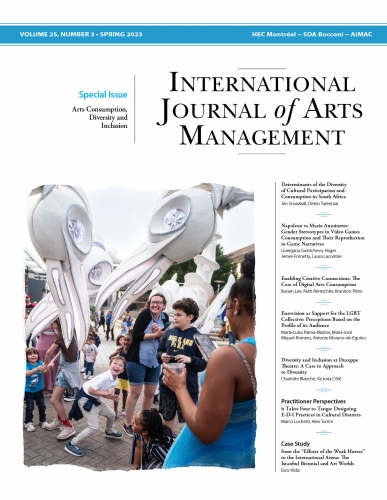It Takes Four to Tango: Designing E-D-I Practices in Cultural District
Produit: Article
21,00 $ CA
(en anglais seulement)
Marco Luchetti, Alex Turrini
Marco Luchetti, PhD candidate at the University of Macerata, is an Academic Fellow and Junior Researcher at Bocconi University, currently working as a consultant for different Italian cultural institutions, such as ATIT – Associazione Teatri Italiani di Tradizione, Macerata Opera Festival, and Fondazione Rete Lirica delle Marche.
Alex Turrini, PhD in Management, is an Associate Professor in Arts Management and Cultural Policy at the Department of Political and Social Sciences at Bocconi University. His research focuses on cultural philanthropy and leadership in the cultural and creative industries. He is a widely published author and editor of books and research papers in academic journals. He is the Co-Editor-in-Chief of the International Journal of Arts Management and the Associate Editor for Europe of the Journal of Philanthropy and Marketing.
ABSTRACT
How do arts institutions and cultural districts deal with diversity and inclusion, and what actions can they take to actively represent the different cultures within a city? Moreover, will these actions be enough? These are some of the challenges that practitioners in the arts are facing in the US and beyond, ever since the Black Lives Matter movement brought them into the spotlight of public debate again. In this paper, we try to answer these questions by focusing on cultural districts, as they are sites where different cultural institutions, possibly representing different values, traditions, and segments of the community, coalesce. As forms of loosely coupled public networks, the actions and behavior of a cultural district in terms of diversity and inclusion are a matter of concern. This paper builds on insights from five anonymous interviews with some of the practitioners involved in a specific cultural district—the Dallas Arts District. Drawing on the practitioners’ perspectives, we propose a conceptual framework that might be conceived as a guide for cultural districts (and cultural institutions) willing to transform themselves into more plural and diverse organizations. The paper will also provide insights for researchers willing to fill the gaps in the arts management literature regarding triggers for diversity and inclusion in the arts ecosystem.
KEYWORDS
Cultural District; Diversity; Inclusion; Cultural Governance; Arts Networks

